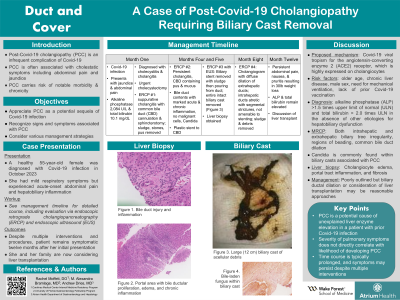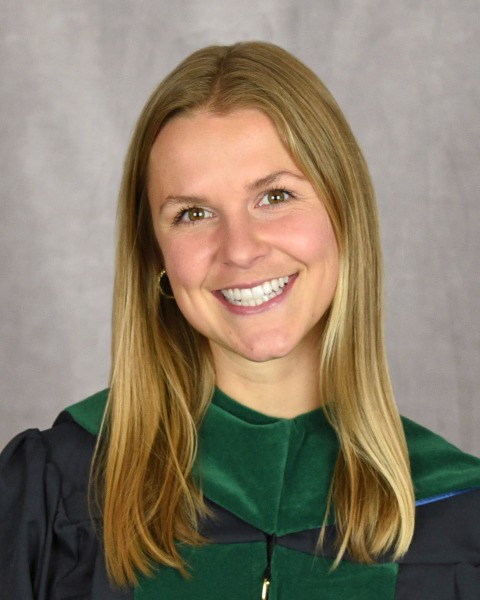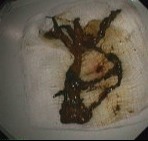Sunday Poster Session
Category: Biliary/Pancreas
P0142 - Duct and Cover: A Case of Post-COVID-19 Cholangiopathy Requiring Biliary Cast Removal
Sunday, October 27, 2024
3:30 PM - 7:00 PM ET
Location: Exhibit Hall E

Has Audio

Rachel Moffett, DO
Carolinas Medical Center Internal Medicine Residency
Charlotte, NC
Presenting Author(s)
Rachel Moffett, DO1, Mary Alexandra Bramlage, MD2, Andrew Dries, MD3
1Carolinas Medical Center Internal Medicine Residency, Charlotte, NC; 2University of Florida, Ponce Inlet, FL; 3Atrium Health, Charlotte, NC
Introduction: Post-Covid-19 cholangiopathy (PCC) is an uncommon but serious complication of Covid-19 infection. One systematic review includes thirty cases within two years. The diagnostic criteria for PCC are not well-defined but typically include alkaline phosphatase (ALP) >1.5 times the upper limit of normal (ULN) and total bilirubin >2 times ULN in the absence of other causes for liver dysfunction. Nearly all individuals studied required endoscopic retrograde cholangiopancreatography (ERCP) in addition to medical therapy, and a small portion underwent a liver transplant.
Case Description/Methods: A healthy fifty-five-year-old female contracted Covid-19 in October 2023. Although she had relatively mild respiratory symptoms, she had acute-onset transaminitis in a cholestatic pattern. Peak serum ALP was 2,084 U/L and total bilirubin was 10.1 mg/dL. Given concern for ascending cholangitis, she underwent ERCP followed by elective cholecystectomy at an outside hospital. She had continued transaminitis and underwent a second ERCP four months later which revealed persistent cholangitis, friable mucosa of the common hepatic duct, and intraductal stones and sludge; she had multiple plastic biliary stents placed. Ongoing symptoms and liver enzyme derangement led her to have a third ERCP with concomitant endoscopic ultrasound (EUS) and subsequent removal of a large (12 mm) biliary cast of acellular debris. Unfortunately, she continues to have pruritus, nausea, and abdominal pain and is considering a liver transplant.
Discussion: PCC is a potential sequela of Covid-19 infection which is infrequently reported but carries risk of significant morbidity. The underlying mechanism is thought to be related to viral tropism for angiotensin-converting enzyme 2 (ACE2) receptors present on intestinal mucosa and hepatocytes. Interestingly, the gastrointestinal tract has the highest density of these receptors compared to all other organ systems, including the respiratory tract. Risk factors associated with PCC include older age, male sex, need for mechanical ventilation, and lack of prior Covid-19 vaccination. Magnetic resonance cholangiography (MRCP) findings include intrahepatic and extrahepatic biliary tree irregularity with regions of beading and common bile duct dilation. Liver biopsy findings include cholangiocyte edema, portal tract inflammation, and fibrosis. Unfortunately, optimal management of PCC remains unclear however liver transplantation may confer benefit in select patients.

Disclosures:
Rachel Moffett, DO1, Mary Alexandra Bramlage, MD2, Andrew Dries, MD3. P0142 - Duct and Cover: A Case of Post-COVID-19 Cholangiopathy Requiring Biliary Cast Removal, ACG 2024 Annual Scientific Meeting Abstracts. Philadelphia, PA: American College of Gastroenterology.
1Carolinas Medical Center Internal Medicine Residency, Charlotte, NC; 2University of Florida, Ponce Inlet, FL; 3Atrium Health, Charlotte, NC
Introduction: Post-Covid-19 cholangiopathy (PCC) is an uncommon but serious complication of Covid-19 infection. One systematic review includes thirty cases within two years. The diagnostic criteria for PCC are not well-defined but typically include alkaline phosphatase (ALP) >1.5 times the upper limit of normal (ULN) and total bilirubin >2 times ULN in the absence of other causes for liver dysfunction. Nearly all individuals studied required endoscopic retrograde cholangiopancreatography (ERCP) in addition to medical therapy, and a small portion underwent a liver transplant.
Case Description/Methods: A healthy fifty-five-year-old female contracted Covid-19 in October 2023. Although she had relatively mild respiratory symptoms, she had acute-onset transaminitis in a cholestatic pattern. Peak serum ALP was 2,084 U/L and total bilirubin was 10.1 mg/dL. Given concern for ascending cholangitis, she underwent ERCP followed by elective cholecystectomy at an outside hospital. She had continued transaminitis and underwent a second ERCP four months later which revealed persistent cholangitis, friable mucosa of the common hepatic duct, and intraductal stones and sludge; she had multiple plastic biliary stents placed. Ongoing symptoms and liver enzyme derangement led her to have a third ERCP with concomitant endoscopic ultrasound (EUS) and subsequent removal of a large (12 mm) biliary cast of acellular debris. Unfortunately, she continues to have pruritus, nausea, and abdominal pain and is considering a liver transplant.
Discussion: PCC is a potential sequela of Covid-19 infection which is infrequently reported but carries risk of significant morbidity. The underlying mechanism is thought to be related to viral tropism for angiotensin-converting enzyme 2 (ACE2) receptors present on intestinal mucosa and hepatocytes. Interestingly, the gastrointestinal tract has the highest density of these receptors compared to all other organ systems, including the respiratory tract. Risk factors associated with PCC include older age, male sex, need for mechanical ventilation, and lack of prior Covid-19 vaccination. Magnetic resonance cholangiography (MRCP) findings include intrahepatic and extrahepatic biliary tree irregularity with regions of beading and common bile duct dilation. Liver biopsy findings include cholangiocyte edema, portal tract inflammation, and fibrosis. Unfortunately, optimal management of PCC remains unclear however liver transplantation may confer benefit in select patients.

Figure: Gross specimen: 12 mm biliary cast
Disclosures:
Rachel Moffett indicated no relevant financial relationships.
Mary Alexandra Bramlage indicated no relevant financial relationships.
Andrew Dries indicated no relevant financial relationships.
Rachel Moffett, DO1, Mary Alexandra Bramlage, MD2, Andrew Dries, MD3. P0142 - Duct and Cover: A Case of Post-COVID-19 Cholangiopathy Requiring Biliary Cast Removal, ACG 2024 Annual Scientific Meeting Abstracts. Philadelphia, PA: American College of Gastroenterology.
